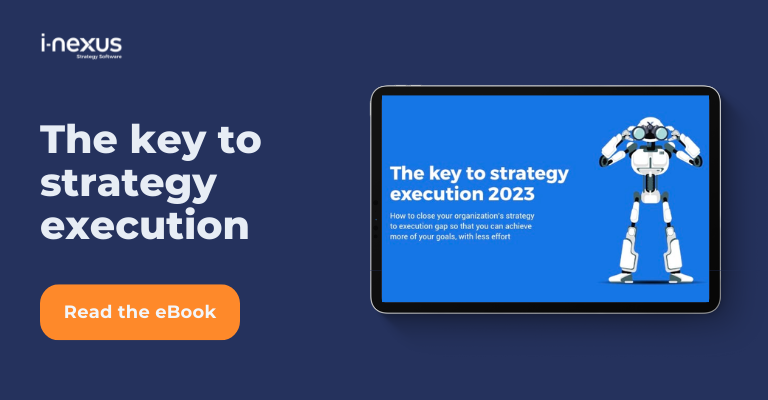Get to know the key strategies you can implement for effective strategy execution management in the first of our 4 part series.
Effective strategy execution truly is the key to translating your business vision into tangible results.
To help you enhance your strategy execution management skills, this series of blogs explores the strategies, best practices, and common challenges you'll face along your journey.
Today's blog serves as an introduction, with many of the topics addressed serving as a preview of future entries in the series.
With that said, let's get into the quick strategies you can put into play to improve the effectiveness of your strategy's execution.
Success starts with understanding Strategy Execution Management
Successful strategy execution starts with understanding what it entails.
Strategy execution management is the process of implementing your strategic plans effectively.
It involves aligning projects, allocating resources, and ensuring that everyone in the organization understands and contributes to the strategy's success.
Common challenges in strategy execution
Strategy execution can be a complex endeavor, and it's not without its challenges. Let's delve into these challenges, and then we'll explore real-world case studies that highlight their impact:
Challenge 1: Lack of alignment
Alignment is fundamental to successful execution. When an organization lacks alignment, it's like a ship with no clear direction.
Departments and teams may work cross-purposes, leading to inefficiency and wasted resources.
Example: A manufacturing organization's strategic initiative
Let's use a fictional example to illustrate this challenge.
Company X, a global manufacturer, launched a strategic initiative to reduce production costs by 15% within a year.
However, during execution, they encountered a lack of alignment between departments. Production changes were delayed, causing financial setbacks.
The lesson here is that alignment is crucial for effective execution.
Challenge 2: Unclear accountabilities
Clear accountabilities are essential to avoid confusion and ensure that tasks and projects move forward as planned.
Projects can stall when responsibilities aren't defined, leading to delays and potential setbacks.
Example: A healthcare organization's digital transformation
Let's use another fictional example to illustrate this challenge.
Healthcare Organization Y embarked on a digital transformation journey to improve patient care and reduce operational costs.
Their challenge was a need for clear accountabilities. When responsibilities weren't defined, project milestones were missed, impacting patient services.
This underscores the importance of clear accountabilities.
You can learn more about how to overcome these challenges with our strategy execution management leadership eBook:
Strategies for successful strategy execution
To overcome these challenges and enhance strategy execution, consider these strategies:
Aligning strategy and execution
Alignment is fundamental because it ensures that everyone in the organization moves in the same direction.
It prevents silos and turf wars, allowing for a more coordinated and effective approach to strategy execution.
Tools like the Hoshin Kanri x-matrix align objectives and resources, providing a clear roadmap for execution.
Clear accountabilities
Clear accountabilities are essential for effective strategy execution.
When individuals and teams clearly understand their roles and responsibilities, it prevents confusion and ensures that projects progress smoothly.
Tools like Objectives and Key Results (OKRs) can set clear, measurable objectives and assign ownership.
Cascading objectives
Cascading objectives throughout the organization create a sense of purpose and unity.
It ensures that employees understand how their work contributes to the larger strategy.
Tools like the catchball process can be used to engage employees in defining and aligning objectives.
Transparency
Maintaining transparency is crucial for successful strategy execution.
Regularly sharing progress, successes, and challenges with all stakeholders keeps everyone informed and engaged.
Transparent communication is a key aspect of the catchball process, which involves ongoing dialogue and feedback.
Best practices in strategy execution management
Some organizations excel in strategy execution. Here are a few best practices drawn from their success:
Accountability and ownership
Successful organizations assign clear ownership of each objective, ensuring focus and alignment.
This practice provides that every strategic objective has a dedicated owner responsible for its execution.
Cascading objectives
They cascade objectives across teams and individuals, making strategy execution part of everyone's job.
This practice ensures that every employee understands their role in achieving the strategic goals.
Continuous communication
Regular, well-defined communication elements keep teams and individuals aligned with execution goals.
This practice involves ongoing communication and feedback loops to ensure everyone is on the same page.
Metrics and success measurement
Measuring success in strategy execution is vital.
Key Performance Indicators (KPIs) help track progress and provide valuable insights into how well your strategy is being executed.
Common KPIs include financial targets, project milestones, customer satisfaction, employee engagement, and more.
The choice of KPIs should align with your strategic objectives and provide a clear picture of progress.
Regularly reviewing and analyzing KPI data allows for adjustments and refinements as needed.
Your takeaways
Incorporating these strategies and best practices into your strategy execution management can help you navigate challenges, drive execution excellence, and ultimately achieve your strategic objectives.
Learning from real-world cases and best practices can lead your organization toward success.
To see more about how you can guide your team's efforts, download our leadership eBook:
Read more about strategy execution and related tools with our content below:
- Key to strategy execution eBook: Read how companies like Danaher and HP have mastered strategy execution and what you can learn from them.
- What role does a Strategy Realization Office play in your strategy execution?: Learn how you can govern your strategy execution with the emerging concept of the Strategy Realization Office (SRO)
- 13 ways to make your team care about goals: Try these 13 ideas for getting your team to buy into your goals, and create real accountability for delivering targets.
About the author
James Milsom is Head of Marketing at i-nexus. As Head of Marketing, his drive is to raise awareness and understanding of the challenges facing enterprises in delivering strategic objectives and transformation amidst changing markets and the obstacles traditional tools and methods present leaders.
If you’d like to talk strategy, contact James at james.milsom@i-nexus.com or connect with him on LinkedIn for the latest insights.


